Abstract
In the first experiment, two rhesus monkeys earned their entire ration of food and water during daily sessions with no provisions to ensure constant daily intakes. Two variable-interval schedules of food presentations were concurrent with one variable-interval schedule of water presentations; the maximum rate of food presentations arranged by one food schedule was varied. As the rate of food presentations was increased, the absolute level of responding on the two food schedules combined decreased, while responding on the water schedule increased. The preference for the variable food schedule compared to the other food schedule approximately matched the proportion of reinforcers obtained from it. The preference for the variable food schedule compared to the water schedule did not match, but greatly decreased, as the proportion of reinforcers from the food schedule increased. When Experiment I was replicated, with provisions to ensure constant daily intakes of food and water (Experiment II), the absolute response rates under the two food schedules combined and under the water schedule no longer changed with increases in the rate of food during the sessions. On the other hand, choice between the two food schedules remained proportional to the distribution of obtained food pellets. These results were interpreted as indicating that behavior to obtain nonsubstitutable commodities, such as food and water, is strongly controlled by the economic conditions of daily consumption, while choice between substitutable commodities is independent of these factors.
Keywords: variable-interval schedules, concurrent schedules, qualitatively different reinforcers, deprivation schedule, undermatching, lever pressing, rhesus monkeys
Full text
PDF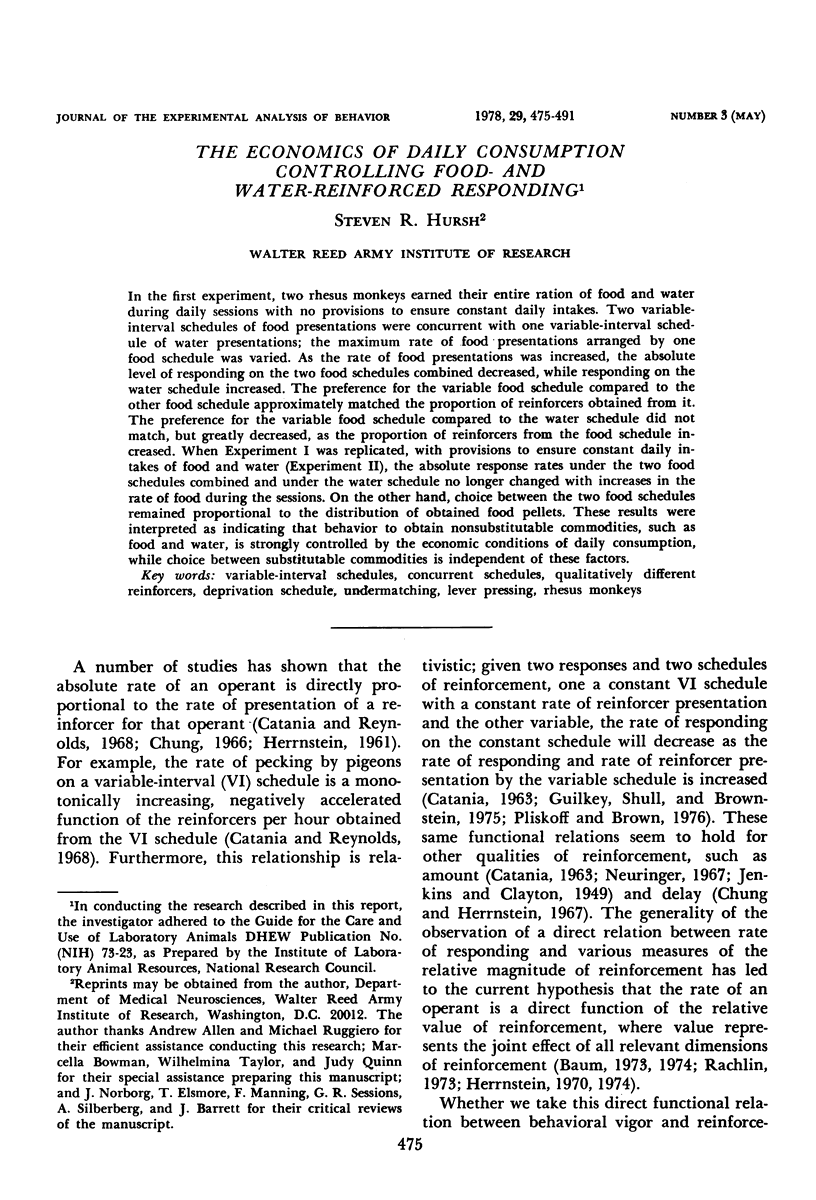


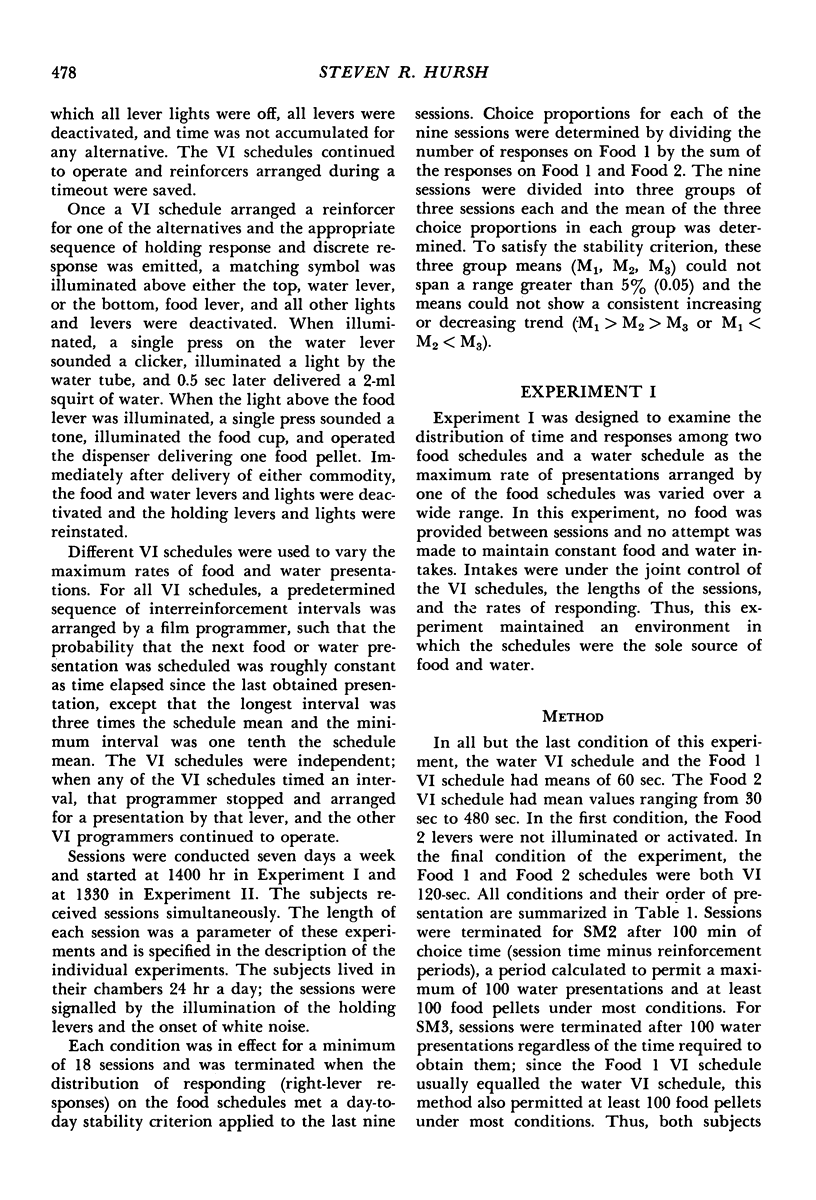



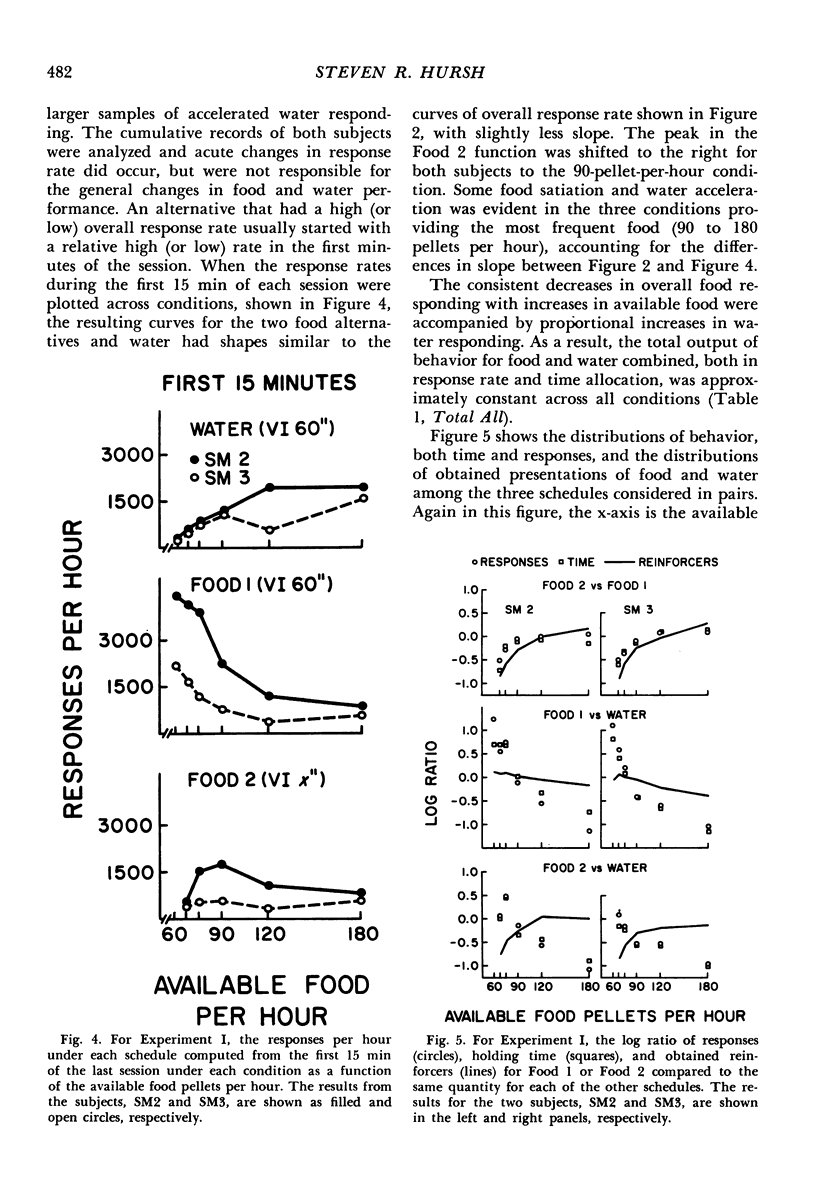

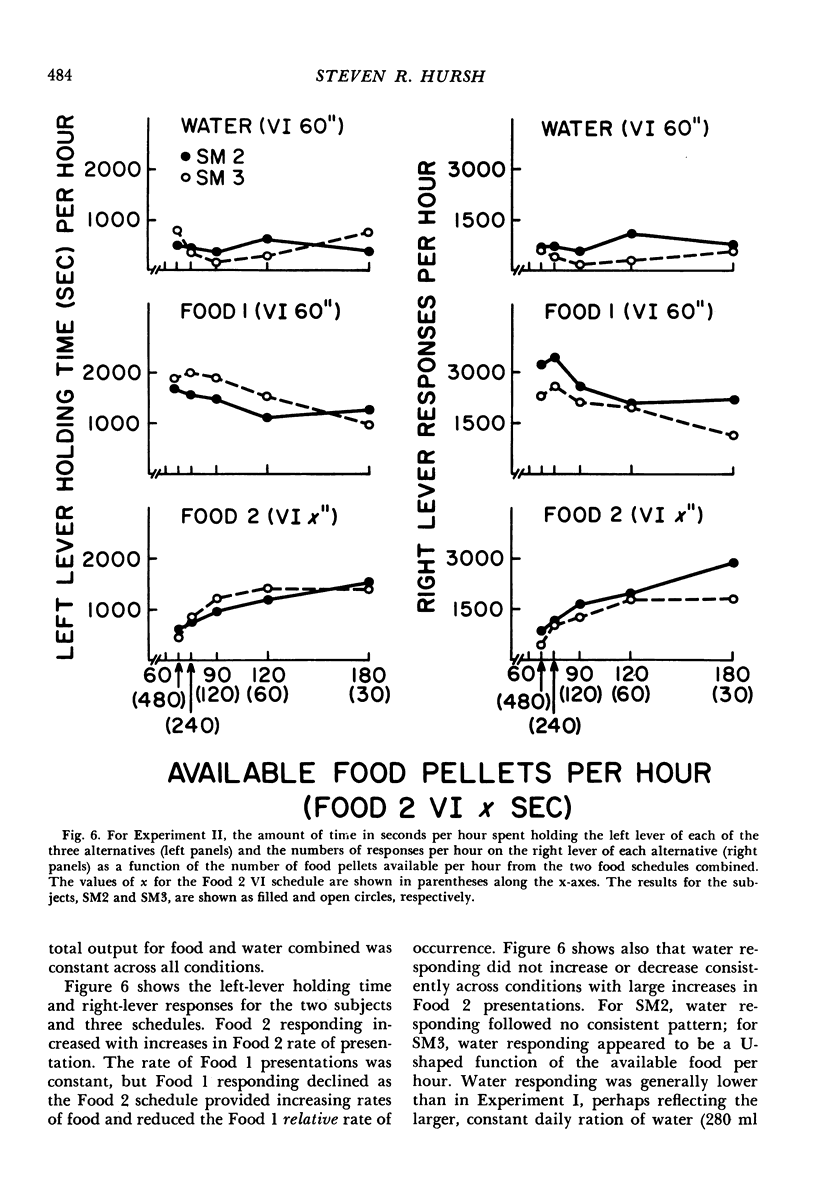
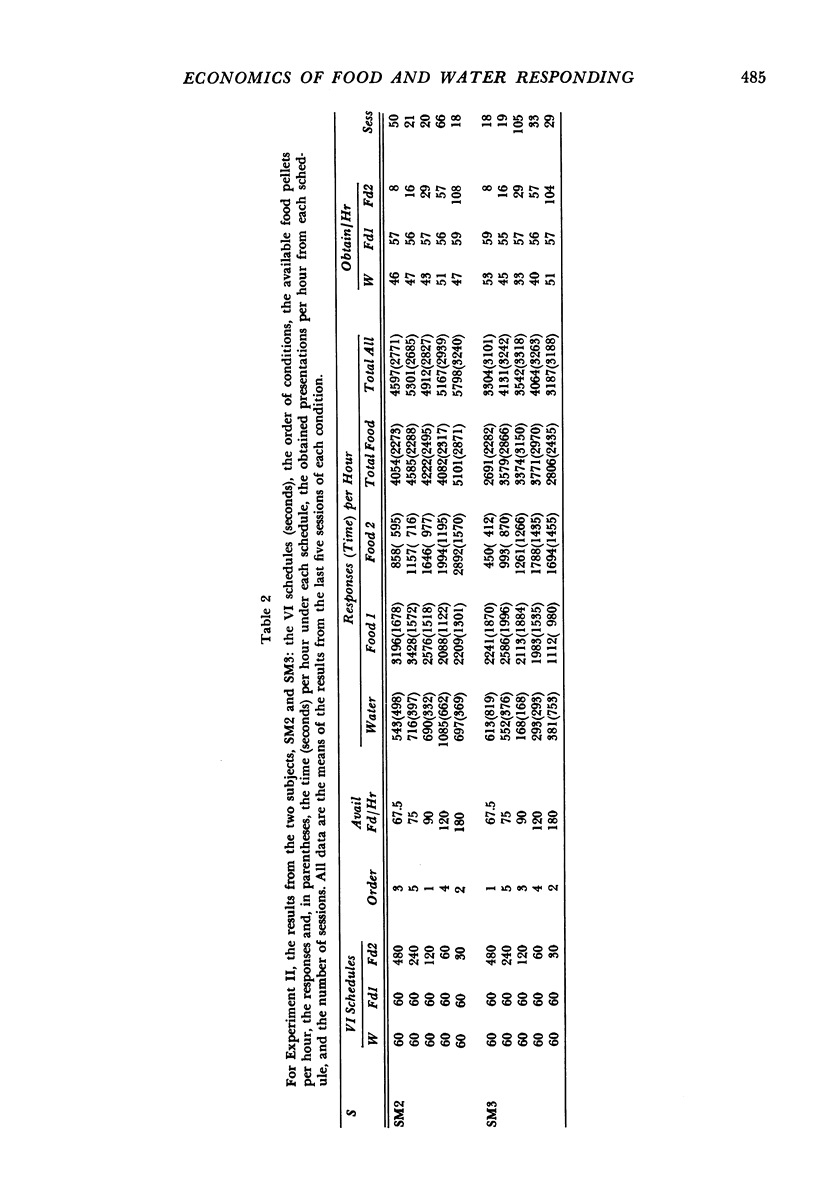
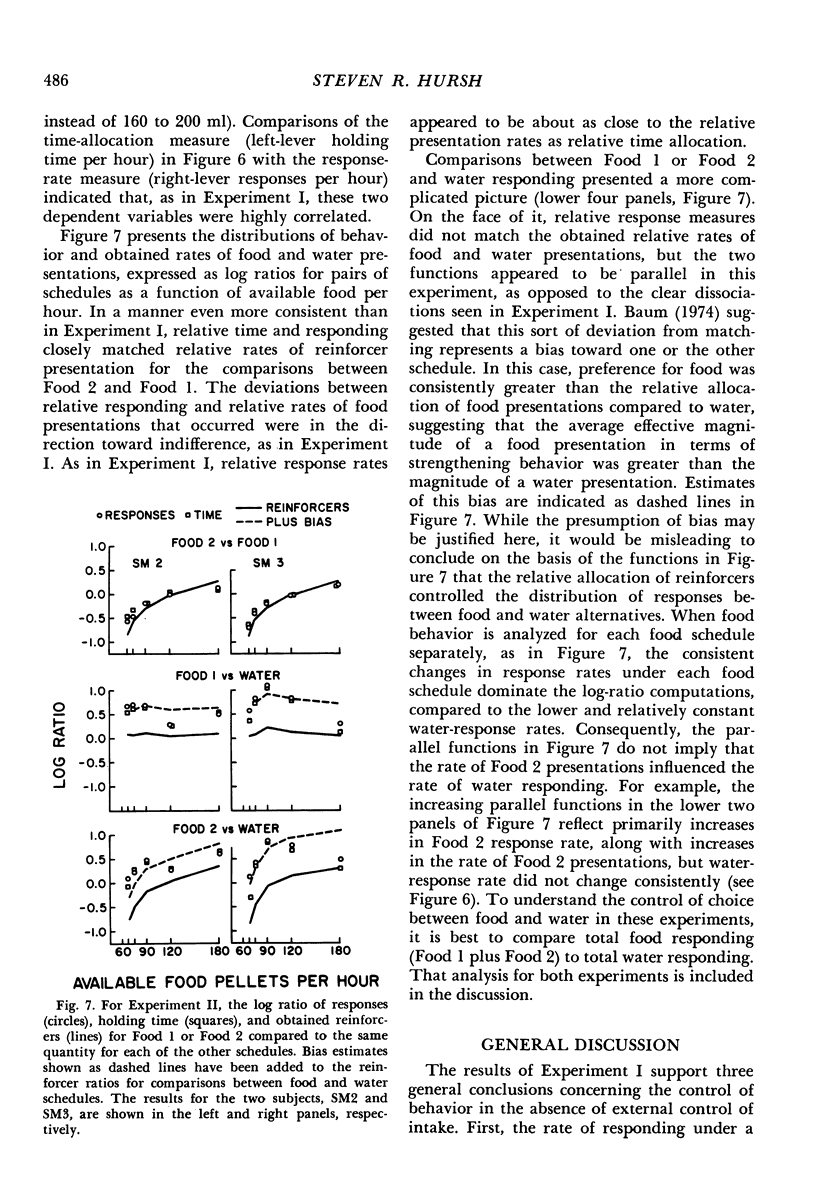
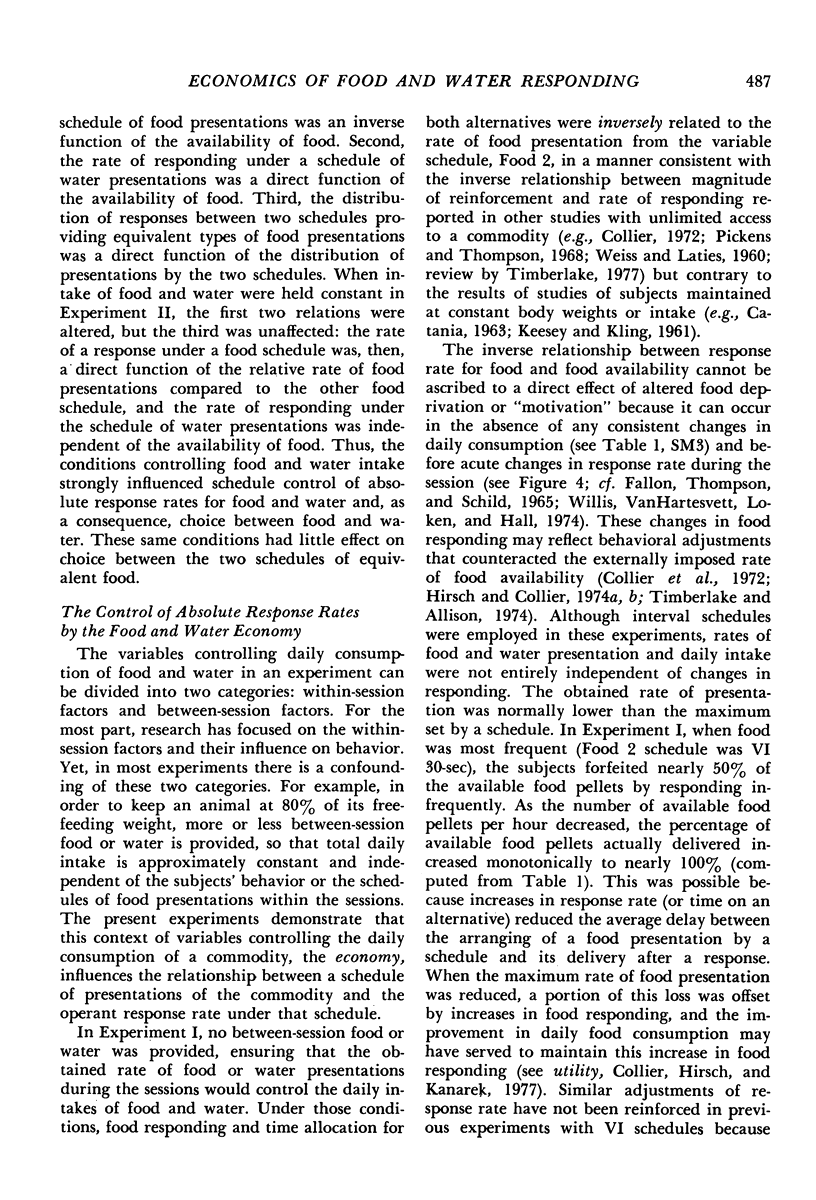
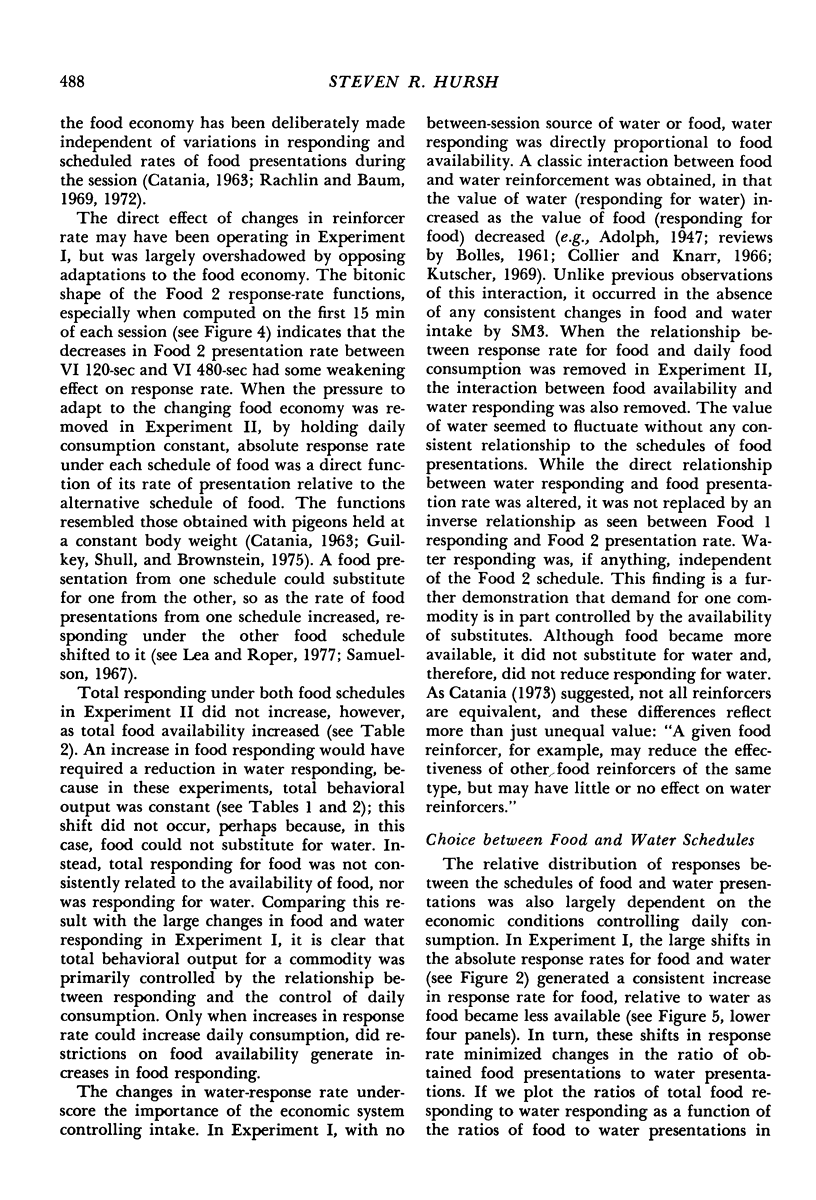

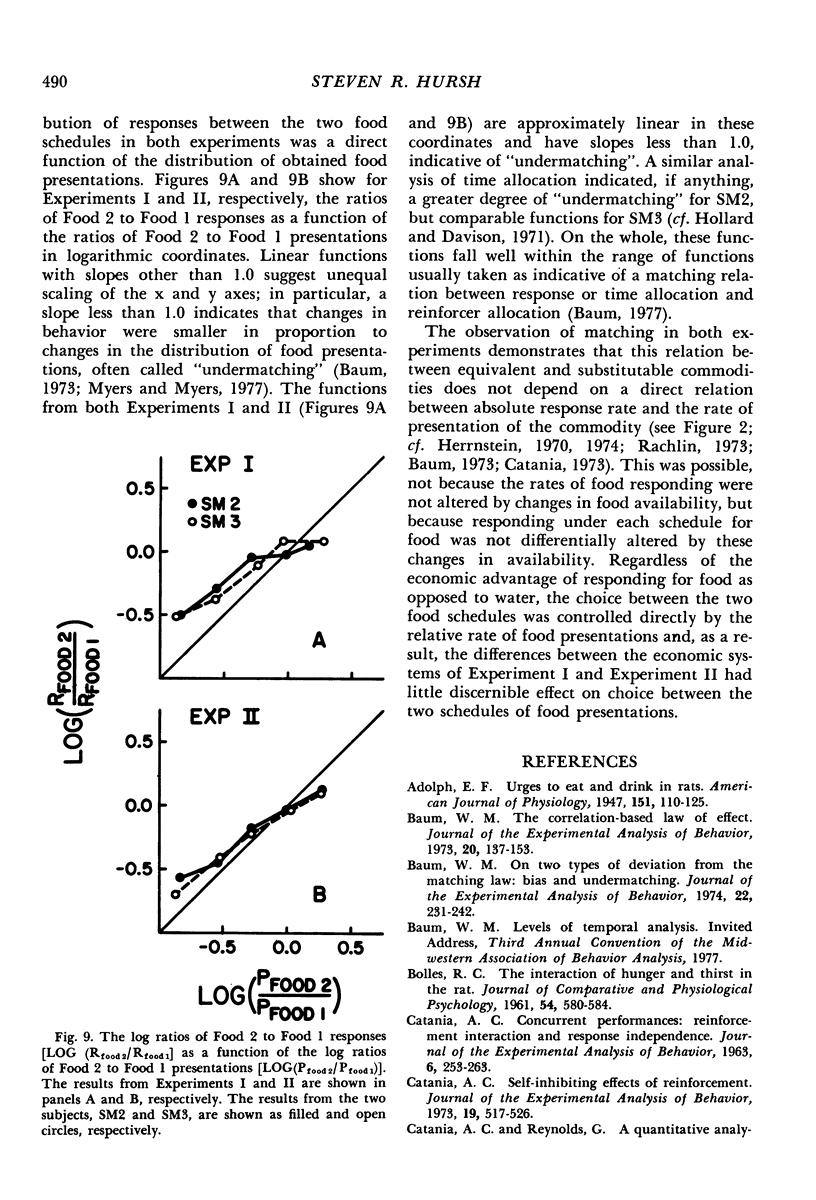
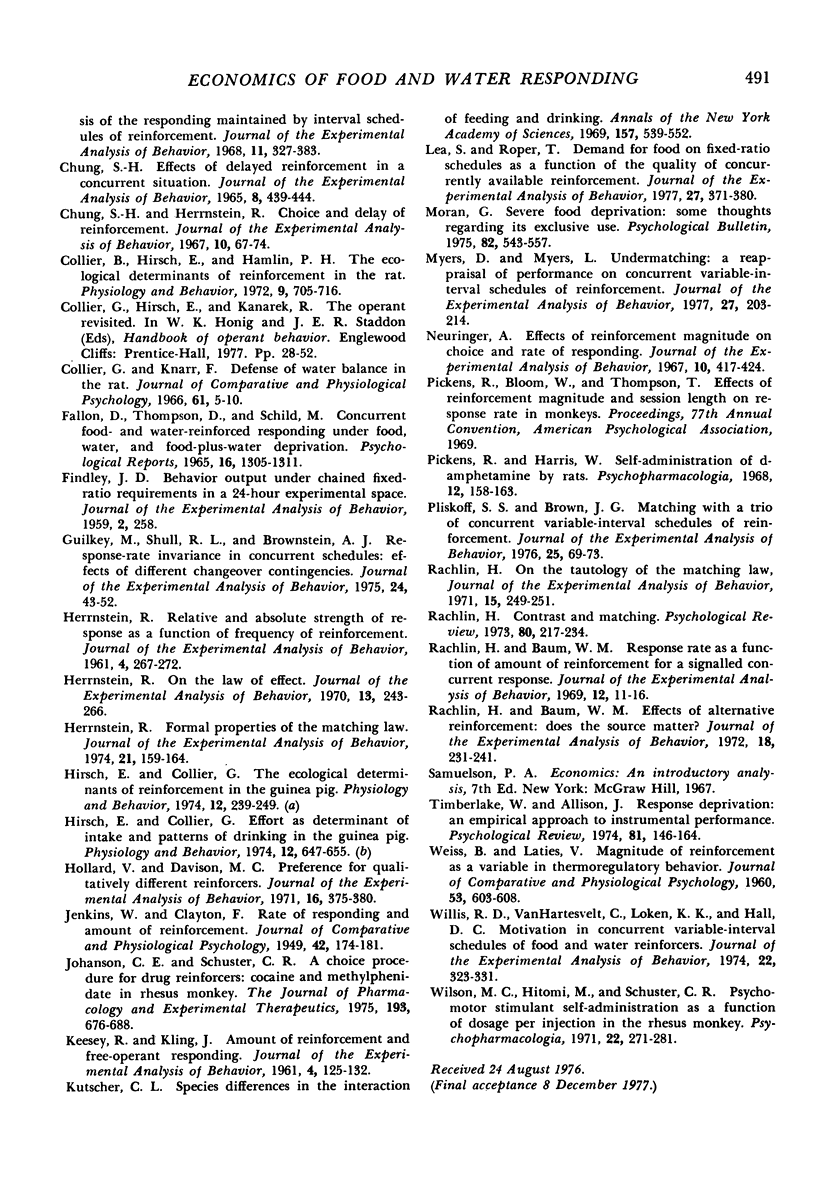
Selected References
These references are in PubMed. This may not be the complete list of references from this article.
- BOLLES R. C. The interaction of hunger and thirst in the rat. J Comp Physiol Psychol. 1961 Oct;54:580–584. doi: 10.1037/h0044595. [DOI] [PubMed] [Google Scholar]
- Baum W. M. On two types of deviation from the matching law: bias and undermatching. J Exp Anal Behav. 1974 Jul;22(1):231–242. doi: 10.1901/jeab.1974.22-231. [DOI] [PMC free article] [PubMed] [Google Scholar]
- Baum W. M. The correlation-based law of effect. J Exp Anal Behav. 1973 Jul;20(1):137–153. doi: 10.1901/jeab.1973.20-137. [DOI] [PMC free article] [PubMed] [Google Scholar]
- CATANIA A. C. Concurrent performances: reinforcement interaction and response independence. J Exp Anal Behav. 1963 Apr;6:253–263. doi: 10.1901/jeab.1963.6-253. [DOI] [PMC free article] [PubMed] [Google Scholar]
- Catania A. C., Reynolds G. S. A quantitative analysis of the responding maintained by interval schedules of reinforcement. J Exp Anal Behav. 1968 May;11(3 Suppl):327–383. doi: 10.1901/jeab.1968.11-s327. [DOI] [PMC free article] [PubMed] [Google Scholar]
- Catania A. C. Self-inhibiting effects of reinforcement. J Exp Anal Behav. 1973 May;19(3):517–526. doi: 10.1901/jeab.1973.19-517. [DOI] [PMC free article] [PubMed] [Google Scholar]
- Chung S. H. Effects of delayed reinforcement in a concurrent situation. J Exp Anal Behav. 1965 Nov;8(6):439–444. doi: 10.1901/jeab.1965.8-439. [DOI] [PMC free article] [PubMed] [Google Scholar]
- Chung S. H., Herrnstein R. J. Choice and delay of reinforcement. J Exp Anal Behav. 1967 Jan;10(1):67–74. doi: 10.1901/jeab.1967.10-67. [DOI] [PMC free article] [PubMed] [Google Scholar]
- Collier G., Dnarr F. Defense of water balance in the rat. J Comp Physiol Psychol. 1966 Feb;61(1):5–10. doi: 10.1037/h0022867. [DOI] [PubMed] [Google Scholar]
- Collier G., Hirsch E., Hamlin P. H. The ecological determinants of reinforcement in the rat. Physiol Behav. 1972 Nov-Dec;9(5):705–716. doi: 10.1016/0031-9384(72)90038-8. [DOI] [PubMed] [Google Scholar]
- Guilkey M., Shull R. L., Brownstein A. J. Response-rate invariance in concurrent schedules: effects of different changeover contingencies. J Exp Anal Behav. 1975 Jul;24(1):43–52. doi: 10.1901/jeab.1975.24-43. [DOI] [PMC free article] [PubMed] [Google Scholar]
- HERRNSTEIN R. J. Relative and absolute strength of response as a function of frequency of reinforcement. J Exp Anal Behav. 1961 Jul;4:267–272. doi: 10.1901/jeab.1961.4-267. [DOI] [PMC free article] [PubMed] [Google Scholar]
- Herrnstein R. J. Formal properties of the matching law. J Exp Anal Behav. 1974 Jan;21(1):159–164. doi: 10.1901/jeab.1974.21-159. [DOI] [PMC free article] [PubMed] [Google Scholar]
- Herrnstein R. J. On the law of effect. J Exp Anal Behav. 1970 Mar;13(2):243–266. doi: 10.1901/jeab.1970.13-243. [DOI] [PMC free article] [PubMed] [Google Scholar]
- Hirsch E., Collier G. Ecological determinants of reinforcement in the guinea pig. Physiol Behav. 1974 Feb;12(2):239–249. doi: 10.1016/0031-9384(74)90178-4. [DOI] [PubMed] [Google Scholar]
- Hirsch E., Collier G. Effort as determinant of intake and patterns of drinking in the guinea pig. Physiol Behav. 1974 Apr;12(4):647–655. doi: 10.1016/0031-9384(74)90215-7. [DOI] [PubMed] [Google Scholar]
- Hollard V., Davison M. C. Preference for qualitatively different reinforcers. J Exp Anal Behav. 1971 Nov;16(3):375–380. doi: 10.1901/jeab.1971.16-375. [DOI] [PMC free article] [PubMed] [Google Scholar]
- Johanson C. E., Schuster C. R. A choice procedure for drug reinforcers: cocaine and methylphenidate in the rhesus monkey. J Pharmacol Exp Ther. 1975 May;193(2):676–688. [PubMed] [Google Scholar]
- KEESEY R. E., KLING J. W. Amount of reinforcement and free-operant responding. J Exp Anal Behav. 1961 Apr;4:125–132. doi: 10.1901/jeab.1961.4-125. [DOI] [PMC free article] [PubMed] [Google Scholar]
- Kutscher C. L. Species differences in the interaction of feeding and drinking. Ann N Y Acad Sci. 1969 May 15;157(2):539–552. doi: 10.1111/j.1749-6632.1969.tb12906.x. [DOI] [PubMed] [Google Scholar]
- Lea S. E., Roper T. J. Demand for food on fixed-ratio schedules as a function of the quality of concurrently available reinforcement. J Exp Anal Behav. 1977 Mar;27(2):371–380. doi: 10.1901/jeab.1977.27-371. [DOI] [PMC free article] [PubMed] [Google Scholar]
- Moran G. Severe food deprivation: some thoughts regarding its exclusive use. Psychol Bull. 1975 Jul;82(4):543–557. doi: 10.1037/h0076799. [DOI] [PubMed] [Google Scholar]
- Myers D. L., Myers L. E. Undermatching: a reappraisal of performance on concurrent variable-interval schedules of reinforcement. J Exp Anal Behav. 1977 Jan;27(1):203–214. doi: 10.1901/jeab.1977.27-203. [DOI] [PMC free article] [PubMed] [Google Scholar]
- Neuringer A. J. Effects of reinforcement magnitude on choice and rate of responding. J Exp Anal Behav. 1967 Sep;10(5):417–424. doi: 10.1901/jeab.1967.10-417. [DOI] [PMC free article] [PubMed] [Google Scholar]
- Pickens R., Harris W. C. Self-administration of d-amphetamine by rats. Psychopharmacologia. 1968;12(2):158–163. doi: 10.1007/BF00401545. [DOI] [PubMed] [Google Scholar]
- Pliskoff S. S., Brown T. G. Matching with a trio of concurrent variable-interval schedules of reinforcement. J Exp Anal Behav. 1976 Jan;25(1):69–73. doi: 10.1901/jeab.1976.25-69. [DOI] [PMC free article] [PubMed] [Google Scholar]
- Rachlin H., Baum W. M. Effects of alternative reinforcement: does the source matter? J Exp Anal Behav. 1972 Sep;18(2):231–241. doi: 10.1901/jeab.1972.18-231. [DOI] [PMC free article] [PubMed] [Google Scholar]
- Rachlin H., Baum W. M. Response rate as a function of amount of reinforcement for a signalled concurrent response. J Exp Anal Behav. 1969 Jan;12(1):11–16. doi: 10.1901/jeab.1969.12-11. [DOI] [PMC free article] [PubMed] [Google Scholar]
- WEISS B., LATIES V. G. Magnitude of reinforcement as a variable in thermoregulatory behavior. J Comp Physiol Psychol. 1960 Dec;53:603–608. doi: 10.1037/h0047935. [DOI] [PubMed] [Google Scholar]
- Willis R. D., Van Hartesveldt C., Loken K. K., Hall D. C. Motivation in concurrent variable-interval schedules with food and water reinforcers. J Exp Anal Behav. 1974 Sep;22(2):323–331. doi: 10.1901/jeab.1974.22-323. [DOI] [PMC free article] [PubMed] [Google Scholar]
- Wilson M. C., Hitomi M., Schuster C. R. Psychomotor stimulant self administration as a function of dosage per injection in the rhesus monkey. Psychopharmacologia. 1971;22(3):271–281. doi: 10.1007/BF00401789. [DOI] [PubMed] [Google Scholar]


